![]()
![]()
![]()
Use LEFT and RIGHT arrow keys to navigate between flashcards;
Use UP and DOWN arrow keys to flip the card;
H to show hint;
A reads text to speech;
118 Cards in this Set
- Front
- Back
|
Kinematic Equations
|
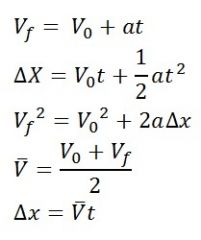
|
|
|
Force of gravity
|

|
|
|
Centripetal Force
|

|
|
|
Torque
|

Vector
|
|
|
Work
|

scalar
|
|
|
Kinetic Energy
|

|
|
|
Work energy theorem
|

|
|
|
Gravitational Potential Energy AND Pendulum Potential Energy
|

|
|
|
Momentum
|

|
|
|
Power
|

W = Work
t = time I = current R = resistance V = voltage |
|
|
Conservation of Momentum in ELASTIC collisions
|

|
|
|
Conservation of momentum in INELASTIC collisions
|

|
|
|
Impulse
|

|
|
|
Efficiency
|

|
|
|
Center of Mass
|

|
|
|
Thermal Expansion
|
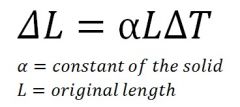
|
|
|
Heat Gained (specific heat)
|

Doesn't apply to phase change
|
|
|
Coulomb's Law
|

|
|
|
Electric Field
|

|
|
|
Electric Potential (Voltage)
|

|
|
|
Electric Potential Energy
|
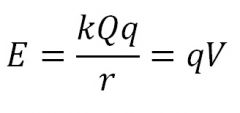
Where V = Kq/r
|
|
|
Phase Change
|
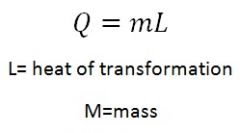
liquid --> solid = heat of fusion
liquid --> gas = heat of vaporization |
|
|
Work done by a gas
|

|
|
|
Entropy for a reversible process
|

|
|
|
Change in internal energy
|

|
|
|
Relations of straight and circular wire to
1) Current 2) Radius |
For both of them:
1) direct relationship 2) inverse relationship |
|
|
Right hand rule (I) for:
direction of magnetic field lines |
Thumb points in direction of I (current) and fingers curls toward mag field lines
|
|
|
Right hand rule (II) for:
Force magnetic field has on a charge |
1) Point thumb in direction of POS charge; (reverse for NEG charge)
2) Point fingers in direction of B 3) Force comes out of palm |
|
|
Current is the flow of _____1_____ while electricity is the flow of ________2________
|
1) Positive charge
2) Electrons |
|
|
Magnetic force on a moving charge
|
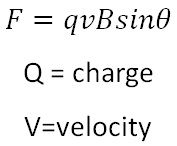
|
|
|
Centripetal force in a magnetic field
|
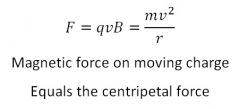
|
|
|
Straight Wire (force of magnetic field on current carrying wire)
|
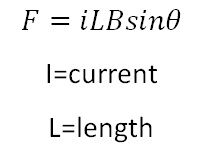
|
|
|
Assuming constant acceleration:
Average Velocity = |
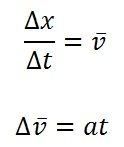
|
|
|
Centripetal Acceleration
|

|
|
|
1st Law of Thermodynamics
|

If the Gas DOES work then work is positive
If work is done ON the gas then work is negative (IN EITHER CASE WRITE THE EQUATION EXACTLY AS IT IS ABOVE), so if the gas does work then U = Q - W Adiabatic (Q=0): U= -W Const Volume: U=Q Const Temp (isothermal): Q=W |
|
|
What does the angular frequency of a SPRING depend on?
|

spring constant and mass
|
|
|
What does the angular frequency of a PENDULUM depend on?
|

gravity and length
|
|
|
Spring Potential energy
|

|
|
|
Charge on a capacitor
|
Q = CV
Q = charge in coulomb C = capacitance (Farad) V = volts |
|
|
What will INCREASE in a capacitor if a dialectric (k>1) is introduced between the plates and then the capacitor charges up?
|
The capacitance increases
The charge stored increases The voltage DOES NOT increase |
|
|
Capacitance of a parallel-plate capacitor
|

|
|
|
Energy of incident light
|

H = plancks consant
f = frequency |
|
|
How does angular frequency relate to frequency (in a pendulum and a spring)
|
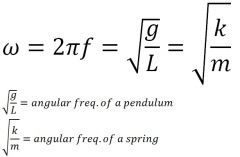
|
|
|
How do you define the direction of an electric field?
|
By how a POSITIVE test charge would behave.
|
|
|
Sound Level related to intensity
|
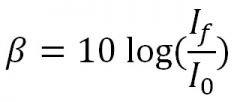
|
|
|
Total energy in a harmonic system
|
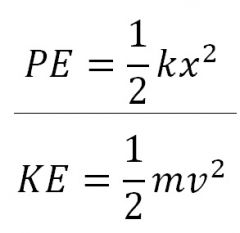
Is equal to the maximum potential or kinetic energy when there are no non-conservative forces acting (like friction/air resistance etc)
|
|
|
Photoelectric effect
|

Energy of the incident photon minus the work function
|
|
|
What happens when you insert a dialectric (k > 1) between a parallel plate capacitor?
|
1) Since the capacitor is connected to a constant voltage source, the voltage remains the same
2) Since Q=CV; and since V is the same and Q goes up then the capacitance must go up 3) Since k>1 then the capacitance increases. If k <1 the capacitance would decrease |
|
|
Does Voltage affect electric field?
|
Yes, stronger voltage = stronger electric field
Voltage does NOT affect electric charge |
|
|
Does charge affect electric field?
|
No
Voltage affects electric fields. Charge magnitude is directly related to energy |
|
|
Volume Expansion
|
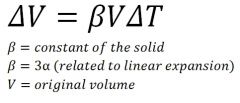
Volume expansion is useful when it comes to liquids and solids
|
|
|
What are the 3 ways to transfer heat energy?
|
1) Conduction - direct transfer via collission
2) convection - heat transfer by physical motion in FLUIDS and GASES only. 3) Radiation - transfer of energy through electromagnetic waves. Radiation can travel through vacuum. |
|
|
How much heat is required to heat something up to its phase change and then complete the phase change?
|
the temp doesn't increase/decrease during the phase change, all the q added goes into changing the phase
|
|
|
Heat required to heat something up to its phase change and then complete the phase change
|

note: the temp is constant during the phase change
|
|
|
What are the 3 major, measurable properties of gasses?
|
1) Temperature - average kinetic energy of gas particles
2) Pressure - the force per unit area 3) Volume - density will be constant after a time |
|
|
What is standard temperature and pressure (STP)
|
273 K
1 atm Volume at STP (22.4L) |
|
|
What is an ideal gas
|
A gas that experiences no intermolecular forces, who PARTICLES occupy no volume.
Gases behave this way at low pressure and high temperature |
|
|
What is the change in internal energy of a mono-atomic ideal gas?
|

For ideal gases, internal energy depends on temp only. If temp is constant, internal energy is constant.
|
|
|
Specific Gravity
|

Ratio of density X to density pure water at 1atm and 4 C
Density of water is 1g/cm^3 or 1000kg/m^3 |
|
|
Absolute Pressure
|

Total pressure exerted on an object submerged in a fluid (liquid or gas)
P0 is pressure at surface |
|
|
Guage Pressure
|

Pressure in a closed space
|
|
|
Pressure in an incompressible fluid (hydraulic)
|
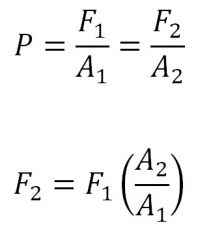
|
|
|
Volume of Fluid displaced in hydraulic system.
|

d = displacement
A = area |
|
|
Work done in a hydraulic system
|

|
|
|
Buoyant force (Archimedes' principle)
|

USE DENSITY OF FLUID!!! NOT DENSITY OF OBJECT!!!
|
|
|
Fluid continuity equation
|

Fluid flows more quickly through narrow passages and slower through wide passages
v = velocity |
|
|
Bernoulli's Equation
|

P = absolute pressure
1/2 pv^2 = dynamic pressure pgy = constant |
|
|
Resistance
|
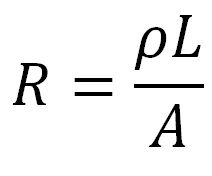
R = resistance
p = resistivity L = length A = cross-sectional area |
|
|
To calculate the voltage drop across a circuit with resistors in series.
|
Calculate the current by adding up all the resistors and using V=IR. Then use that calculated value of I to determine the voltage drop across each resistor using V=IR again.
|
|
|
Resistance in a parallel circuit
|

Voltage across each path is the same
|
|
|
Potential Energy of a capacitor
|

C = capacitance
V = voltage |
|
|
Capacitors in series add like resistors in ___________
|
parallel.
1/C = 1/C1 + 1/C2 - series 1/R = 1/R1 + 1/R2 - parallel |
|
|
Capacitors in parallel add like resistors in ____________
|
series
C = C1 + C2 - parallel R = R1 + R2 - series |
|
|
How does root mean square of Current and Voltage relate to their max values?
|

|
|
|
Capacitors in series
|

|
|
|
Gauss
|
Smaller units of the SI unit Tesla.
1 Gauss = 1 X 10^ -4 T |
|
|
Focal Length (for all spherical mirrors)
|
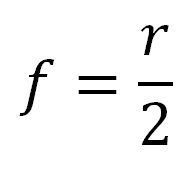
distance between the focal point and the mirror
r = radius of curvature |
|
|
Mirror Distance Relationships
Applies to both kinds of mirrors and both types of lenses! |

o = object distance
i = image distance f = focal length r = radius of curvature |
|
|
Flat Mirror Distance Relationships
|
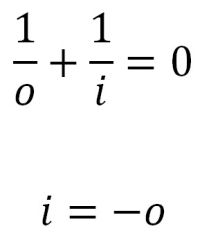
Think of it as an infinitely large spherical mirror
|
|
|
Magnification
|

Positive magnification means upright images
Negative magnification means upside down images |
|
|
What is the only type of image produced from a single diverging (convex) mirror?
|
Virtual
Upright Reduced (mag < 1) Regardless of position of object |
|
|
Refraction
|
Bending of light as it passes from one medium to another and changes speed
|
|
|
Snell's Law
|
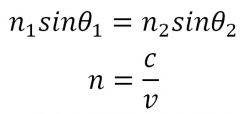
n1 = medium from which light is coming
n2 = medium where light is entering c = speed of light in vacuum v = speed of light in medium |
|
|
What happens when light enters a medium with a higher index of refraction?
n2 > n1 |
The light bends towards the normal and angle 2 is less than angle 1
|
|
|
What is the critical angle
|
The angle for which the refracted angle is 90 degrees. Beyond this angle there is total internal reflection
|
|
|
Critical Angle
|
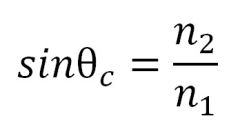
The angle for which the refracted angle is 90 degrees. Every angle past that observes total internal reflection
|
|
|
Lens Maker's Equation
|

For lenses where the thickness cannot be neglected
focal length is related to the curvature of the lens and the index of refraction of the lens |
|
|
What is the REAL (R) side of a lens or mirror?
|
Where the light actually goes.
For mirrors it's on the incident side. For lenses it's on the other side of the lens |
|
|
Lens Power
|
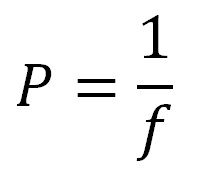
f = focal length (meters)
Lens power is measured in diopters |
|
|
Sign conventions for lens focal point
|
POSITIVE - for a converging lens
NEGATIVE - for a diverging lens |
|
|
Sign conventions for mirror focal point
|
POSITIVE - for concave mirror
NEGATIVE - for convex mirror |
|
|
Sign convention for radius in mirrors
|
POSITIVE - CONVEX mirrors
NEGATIVE - CONCAVE mirrors important for lensmakers eq. If the lens is symmetrical then the radii ar equal but opposite in sign for a diverging lens. 1/f = (n-1)(-2/r) <--- |
|
|
Energy Emitted per second from a body
|

Note that if the Temp is increased the energy emitted increases by a factor of 4!
Also, when the temperature doubles, the peak wavelength is halved. |
|
|
Work Function
|

F = threshold frequncy (freq. that will eject an electron from metal)
Photoelectric effect |
|
|
What is the kinetic energy of an electron ejected from a metal atom via the photoelectric effect?
|

It is the difference between the energy of the incident photon and the threshold energy of the electron on the atom
|
|
|
What does the speed of an ejected electron depend on in the photoelectric effect?
|
The color (frequency/wavelength) of the incident photon...NOT THE INTENSITY
NOTE: Increasing the brightness (intensity) does eject more electrons, but their speed is the same. |
|
|
Quantized Angular Momentum (in a Bohr atom)
|
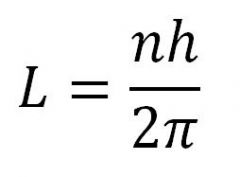
Note that as n increases the angular momentum increases.
Therefore the higher n, the more energy the electron has |
|
|
What are the energy levels for hydrogen in electron volts?
|

as "n" increases, the total electron volts get less negative and therefore higher in energy.
|
|
|
Energy of electron transitions in hydrogen orbitals
|
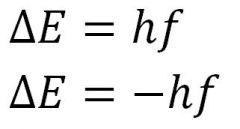
if E = negative then electron has gone from a higher state to a lower state
if E is positive the electron has absorbed a photon and jumped from a lower state to a higher state |
|
|
Frequency of light emitted from an electron falling from a higher orbit to a lower one
|

Delta E is from Ef-Ei (-13.6/n^2)
|
|
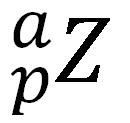
|
Z = Atomic Symbol
a = atomic mass (protons + neutrons) p = number of protons |
|
|
Alpha Decay
|
The emission of an "a" particle, which is a helium nucleus with no electrons (so it carries a +2 Charge) (2 protons and 2 neutrons)
The "a" particle's daughter will be 2 units less in atomic number and will be 4 units less in mass. |
|
|
Alpha decay generalized reaction
|

|
|
|
Beta Decay general reaction
|

|
|
|
Beta Decay
|
Beta Minus - a neutron turns into a proton and an electron and beta-minus particle are emitted
Beta pos - a proton splits into a positron and a neutron and a beta-negative particle is created |
|
|
Gamma Decay
|
Emits a massless energy photon which simply lowers the energy of the parent
No changes in mass or charge take place |
|
|
Modulus
|

|
|
|
1) Young's Modulus
2) Shear Modulus 3) Bulk Modulus |
1) Measures stiffness, (^L/L)
2) Lateral deformation (x/h) where x is lateral movement and h is original height 3) Bulk Modulus, (^V/V) measures change in volume |
|
|
What are the approximate wavlengths of:
1) RED LIGHT 2) VIOLET LIGHT |
1) RED ~ 700nm
2) VIOLET ~ 400nm |
|
|
When focal length is positive or negative...
|
Positive - converging
Negative - diverging |
|
|
When i is positive or negative...
|
Positive - real image
Negative - virtual image |
|
|
When o is positive or negative...
|
Positive - Object is on same side as light going in
Negative - Object is on opposite side of light going in |
|
|
When m is positive or negative...
|
Positive - image is upright
Negative - image is inverted |
|
|
For Converging mirrors
1) Outside Focal point 2) at focal point 3) inside focal point |
1) Outside - Real, inverted and magnified image
2) no image 3) virtual, upright, magnified |
|
|
For Diverging Mirrors
1) Outside Focal point 2) at focal point 3) inside focal point |
ALWAYS virtual, upright, reduced
|
|
|
For Converging Lenses
1) Outside Focal point 2) at focal point 3) inside focal point |
1) Real, inverted, magnified (note real image is on opposite side of LENS as object)
2) no image 3) Virtual, upright, magnified |
|
|
For Diverging Lenses
1) Outside Focal point 2) at focal point 3) inside focal point |
ALWAYS virtual, upright and reduced
|
|
|
Power
conceptual |
Energy / Time
|

